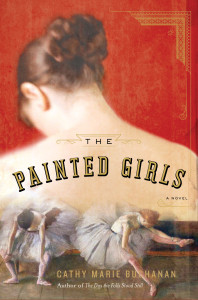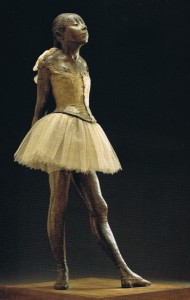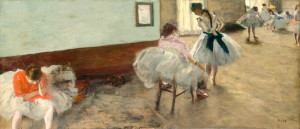Art in Historical Fiction Interview Series featuring Cathy Marie Buchanan
Stephanie Renee dos Santos
 Welcome to week eight of our series. It’s my pleasure to introduce Cathy Marie Buchanan, author of bestseller The Painted Girls. Set in 1878 Paris, the Goethem sisters and their mother find themselves abandoned, their lives upended after the sudden death of the man of the family. Struggling to make ends meet with the fear of eviction, as their mother disappears into the fog of absinthe, the girls must find ways to survive and to help their ailing laundress mother. Marie, the youngest, finds work as a ballerina in training for the Paris Opéra, while Antoinette, the oldest, pursues the theater and falls into a dangerous love affair. Practicing for the ballet, Marie is noticed by artist Edgar Degas and soon begins posing for his works, and will be immortalized in bronze as the sculpture known as “Little Dancer Aged Fourteen”. But the world of art has its dark characters, as Marie soon finds out, while her sister plummets into the seedy underbelly of “civilized society” and must make a choice as to which life path to ultimately pursue. In The Painted Girls, Buchanan has brought to light and life the unexposed shadows of the glittering grand Belle Époque era in Paris, exposing a tarnished world hidden behind glamorous stages and exquisite works of art.
Welcome to week eight of our series. It’s my pleasure to introduce Cathy Marie Buchanan, author of bestseller The Painted Girls. Set in 1878 Paris, the Goethem sisters and their mother find themselves abandoned, their lives upended after the sudden death of the man of the family. Struggling to make ends meet with the fear of eviction, as their mother disappears into the fog of absinthe, the girls must find ways to survive and to help their ailing laundress mother. Marie, the youngest, finds work as a ballerina in training for the Paris Opéra, while Antoinette, the oldest, pursues the theater and falls into a dangerous love affair. Practicing for the ballet, Marie is noticed by artist Edgar Degas and soon begins posing for his works, and will be immortalized in bronze as the sculpture known as “Little Dancer Aged Fourteen”. But the world of art has its dark characters, as Marie soon finds out, while her sister plummets into the seedy underbelly of “civilized society” and must make a choice as to which life path to ultimately pursue. In The Painted Girls, Buchanan has brought to light and life the unexposed shadows of the glittering grand Belle Époque era in Paris, exposing a tarnished world hidden behind glamorous stages and exquisite works of art.
Let the show begin…
Stephanie Renée dos Santos: Was the inclusion and appearance of 19th century French painter Edgar Degas planned for The Painted Girls or did his inclusion evolve organically with the Paris Opera House and ballerina’s story?
Cathy Marie Buchanan: Edgar Degas was part of the story from the outset. I had come upon an art history documentary on his famous sculpture “Little Dancer Aged Fourteen” (http://www.youtube.com/watch?v=XDREBSf6IAE), and as I watched the documentary I grew more and more certain that my next novel would tell the story of the real life model for the artwork.
SRDS: What compelled you to include art and artist in your historical novel?
 CMB: While watching the documentary, I would learn that on the sculpture’s unveiling back in 1881, the public linked “Little Dancer” with a life of vice and young girls for sale. She was called a “flower of the gutter” and her face was said to be “imprinted with the detestable promise of every vice.” Such notions were underpinned by a long history of often less-than-noble liaisons between the young dancers at the Paris Opera Ballet and the wealthy male season ticketholders. I would also learn of the poverty of the girl—Marie van Goethem— who had modeled for the work. The revelations flew in the face of my modern day notions of the sculpture and ballet as largely a high-minded pursuit of privileged girls. I was fascinated, and knew Marie’s story was one I wanted to tell.
CMB: While watching the documentary, I would learn that on the sculpture’s unveiling back in 1881, the public linked “Little Dancer” with a life of vice and young girls for sale. She was called a “flower of the gutter” and her face was said to be “imprinted with the detestable promise of every vice.” Such notions were underpinned by a long history of often less-than-noble liaisons between the young dancers at the Paris Opera Ballet and the wealthy male season ticketholders. I would also learn of the poverty of the girl—Marie van Goethem— who had modeled for the work. The revelations flew in the face of my modern day notions of the sculpture and ballet as largely a high-minded pursuit of privileged girls. I was fascinated, and knew Marie’s story was one I wanted to tell.
SRDS: What drew you to your specific visual art medium, art work, and artist?
As a teenager I spent four, sometimes five, nights a week in the ballet studio and there were in fact Edgar Degas ballet girl prints on the walls of the studio where I took most of my classes. I felt kinship with his ballet girls. Sometimes he drew or painted them in all their glory on the stage, but often as not, he captured them limbering at the barre or rubbing the stiffness from a muscle, just like I was. I saw their love of dance, too; again, no different from my own. No wonder, then, that decades later a documentary on Degas’s most famous sculpture, “Little Dancer Aged Fourteen”, should inspire me to write a novel.
SRDS: How did you go about incorporating art and artist into the book?
CMB: I researched the known facts of Marie van Goethem and her sisters’ lives and what is known about the making and exhibition of the sculpture. I stuck to those facts, treating them as guiding lights while writing the story. What is known, though, is scant, and that left lots of room for imagination.
SRDS: Do you have any message you were trying to convey by including art and artist in the novel?
 CMB: I do love the idea of readers looking at Degas’s artwork though a new lens after reading The Painted Girls, and I’ve heard from many readers that they have gone in search of his artwork and, in fact, seen it with new eyes.
CMB: I do love the idea of readers looking at Degas’s artwork though a new lens after reading The Painted Girls, and I’ve heard from many readers that they have gone in search of his artwork and, in fact, seen it with new eyes.
SRDS: What story lines do you see as unexplored in this niche of art in fiction?
Too many to mention! I think flipping through the pages of an art book and trying to imagine the lives of some of the subjects would provide pretty fertile ground for story ideas.
SRDS: What do you think readers can gain by reading stories with art tie-ins?
CMB: Readers, hopefully, gain a new appreciation for an artist’s body of work and the times in which he lived.
SRDS: Why does fiction with art and artists matter?
CMB: I’m not sure that fiction with art and artists matters more than other fiction. I think the best fiction brings some insight into human nature to the reader. Certainly this can be accomplished in novels with art as an aspect, but it is not limited to such novels.
SRDS: Are you working on a new historical novel with an art and artist(s) thread? If so, please share with us a bit about the upcoming book.
CMB: No, my work in progress is another work of historical fiction. This one is set 2000 years ago in Iron Age Britain on the eve of Roman conquest.
SRDS: Any further thoughts on art in fiction you’d like to share or expand on?
CMB: It’s my tendency when looking at art to wonder about the lives of the subjects. I expect I am not alone in this. Perhaps it explains the large body of fiction inspired by visual art.
 About the author: Cathy Marie Buchanan’s The Painted Girls is a #1 National Bestseller in Canada, a New York Times bestseller, and has garnered rave reviews and been showered with special attention—everything from selection as a People Magazine pick to inclusion in Entertainment Weekly’s Must List to being named a best book of 2013 by NPR, Good Housekeeping and Goodreads. Her debut novel, The Day the Falls Stood Still, is a New York Times bestseller and a Barnes & Noble Recommends selection. She holds a BSc (Honours Biochemistry) and an MBA from Western University. Born and raised in Niagara Falls, Ontario, she now resides in Toronto with her husband and three sons.
About the author: Cathy Marie Buchanan’s The Painted Girls is a #1 National Bestseller in Canada, a New York Times bestseller, and has garnered rave reviews and been showered with special attention—everything from selection as a People Magazine pick to inclusion in Entertainment Weekly’s Must List to being named a best book of 2013 by NPR, Good Housekeeping and Goodreads. Her debut novel, The Day the Falls Stood Still, is a New York Times bestseller and a Barnes & Noble Recommends selection. She holds a BSc (Honours Biochemistry) and an MBA from Western University. Born and raised in Niagara Falls, Ontario, she now resides in Toronto with her husband and three sons.
Join us here next Saturday July 26th for an interview with Alicia Foster, author of Warpaint.
Interview posting schedule: May 31st Susan Vreeland, June 7th Mary F. Burns, June 14th Michael Dean, June 21st Donna Morin Russo, June 28th Alana White, July 5th Maryanne O’Hara, July 12th Stephanie Cowell, July 19th Cathy Marie Buchanan, July 26th Alicia Foster
 About the contributor: Stephanie Renée dos Santos is a fiction and freelance writer and leads writing & yoga workshops. She writes features for the Historical Novel Society. Currently, she is working on her first art-related historical novel, CUT FROM THE EARTH. A story of Portuguese tile and its surprising makers – The Great Lisbon Earthquake of 1755 — and the wisdom of nature to guide and heal. www.stephaniereneedossantos.com & Join Facebook group “Love of Art in Fiction“
About the contributor: Stephanie Renée dos Santos is a fiction and freelance writer and leads writing & yoga workshops. She writes features for the Historical Novel Society. Currently, she is working on her first art-related historical novel, CUT FROM THE EARTH. A story of Portuguese tile and its surprising makers – The Great Lisbon Earthquake of 1755 — and the wisdom of nature to guide and heal. www.stephaniereneedossantos.com & Join Facebook group “Love of Art in Fiction“






